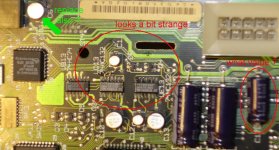Hi Z80.
I just unearthed my awesome IIci project from the 80's and it is exhibiting the exact same symptoms. So before I "run it through the dishwasher" or "replace every capacitor on the board" and other broad brush approaches that seem to defy all logic, let's dig into this and narrow it down. Wow, the diagram of the startup circuit for these things from uniserver is an awesome start, no! Let's figure out why the power circuit/power supply is doing this rather than starting the dishwasher and warming up the soldering iron. So here is my story with troubleshooting steps etc:
1. First time starting up with MB-based video, all good. 80 megs of RAM, System 7.5, internal 2 gig SCSI hard drive, a bunch of my old files, all good, 16 bit Missile Command with trackball, Pagemaker, Asante nic (I may try to get online with this using Netcrape 2.0), etc etc. Good Times.
2. Shut down to change my video card, restarted, clickety click power supply issue, no start.
3. Pulled Power Supply. Opened, fuses good fan spinning. Put it back in, started.
4. Shut down, popped in my Raster Ops 1988 "Millions of Colors" Nubus card, Excellent! back in business. Here's a pic: (tried to cut and paste a jpeg in, even after reducing it to 10% 68kMLA grumbled

let me know how to bring in pics)
5. Now to test external SCSI with my custom external drive and 2x CD-Rom. Shut Down.
6. Attached external SCSI and terminated, set to SCSI 1, etc. Clickety Click issue, no start.
7. Pulled and reseated power supply, no change. Turned off power at power strip for 5 min, back on, no change.
8. Walked away to get on with my life and came back. Fired right up.
9. The CMOS battery (call it whatever you want, think different, it's still a CMOS battery) is completely dead, ie the date was 1901, and the time/date keeps changing etc. Please someone define the use of this battery (specifically for the IIci) beyond saving parameters at the base level (window settings, time, date, etc) A CMOS battery just like anything else that needs power to save volatile memory just like a PC, game console, etc etc etc. It is my understanding that this battery is only for this purpose and has nothing to do with whether the machine will boot or not.
10. Bring me into the know on the use of capacitors (on this model only IIci) to store and relay power. So is the unit in some sort of standby mode still pulling in power and these caps regulate that and keep it ready to boot??
11. We'll figure this out!! I need my xlnt example of Cupertino engineering to start every time I press the keyboard button, just like in the 80's.
Thanks in advance!



